Tools & Platforms
AI Tutoring Services Market Share and Forecast 2025–2035
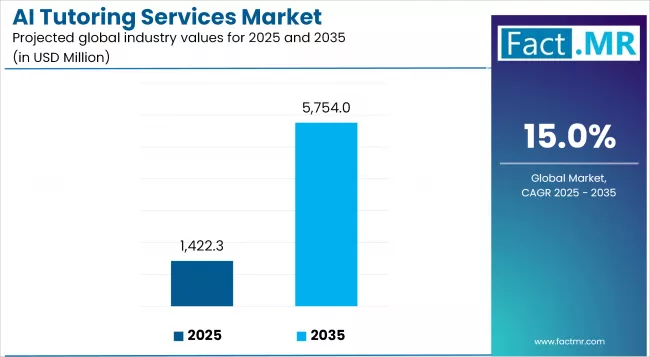
AI Tutoring Services Market Outlook (2025 to 2035)
The global AI tutoring services market is expected to reach USD 5,754 million by 2035, up from USD 1,422 million in 2025. During the forecast period 2025 to 2035, the industry is projected to expand at a CAGR of 15.0%.
Growth in customized learning, improved natural language processing and generative AI, and the demand for affordable and scalable educational opportunities propel the AI tutoring services market. The interactive and human approach that the AI tutors can follow and their ability to accommodate the needs of individual students, as well as their flexibility in hours, make them useful in both the advanced and emerging markets. These have been contributing to the growth of adoption in the schools, universities, and corporate trainings and to the general initiatives of making education more inclusive and effective.
Quick Stats for AI Tutoring Services Market
- Industry Value (2025): USD 1,422.3 Million
- Projected Value (2035): USD 5,754 Million
- Forecast CAGR (2025 to 2035): 15.0%
- Leading Segment (2025): Machine Learning & Predictive Analytics (52% Market Share)
- Fastest Growing Country (2025-2035): India (15.9% CAGR)
- Top Key Players: Brainly, McGraw-Hill., CK-12 Foundation, Chegg, Duolingo, Pearson, Sizzle, TutorEva, and Varsity Tutors
What are the drivers of the AI tutoring services market?
The increasing popularity of personalized learning experiences is one of the biggest factors that promote the growth of the AI tutoring services market these days. Conventional classroom environments can be inadequate in accommodating learner differences in terms of pace, and therefore, students fail to learn at their own customized pace. AI tutors can customize lessons, provide feedback, and offer practice exercises. This personalization enhances student engagement, retention and performance, and that is why schools, universities, and parents are heavily adopting AI-driven solutions.
The second driver is the dynamic development of natural language processing and generative AI technology. These advancements allow the AI tutors to engage in more lifelike and closer-to-natural conversations, tutoring in a step-by-step fashion, and even grading open-ended responses like essays. AI tutoring solutions can no longer be viewed as solely offering basic multiple-choice practice but are getting more interactive and contextual.
The increasing global pressure on accessible and affordable education is also a contributing factor towards this, as in most regions, particularly emerging markets, there is a scarcity of qualified educators and instructors. The use of I tutors can fill this gap since they are available 24/7 at a much lower rate than human tutors. The scalability is beneficial not only to individual learners but also to incorporate government and institutional interests to benefit education in terms of inclusiveness and equity.
What are the regional trends of the AI tutoring services market?
In North America, the AI tutoring services market is the most advanced in the world, and the United States is leading the race. Its high adoption in both the K-12 and higher education segments, as well as corporate training has been boosting growth, as there is already early integration of generative AI tools in classrooms.
Asia-Pacific has a market growing at the fastest rate, and this is driven by huge student populations in places such as China and India. Digitalized education programs and guided by governments, and the widespread use of educational applications on smartphones are fueling the pace of AI tutor adoption.
In Europe, the trend is stable since schools and colleges are implementing AI tutors in language training and STEM tutoring. The regulatory environment regarding AI in education is prompting adoption with an eye toward ethical and data-compliant ideas.
In Latin America and the Middle East & Africa, uptake is increasing rapidly, but it is still in an early phase. AI tutors are a potential solution to limitations of access to teachers and the high demand for affordable education, and have already participated in pilot programs with positive results.
What are the challenges and restraining factors of the AI tutoring services market?
An important issue in the market of AI tutoring services is providing accuracy and reliability with editing of learning content. Although AI tutors have high speed in creating explanations and feedback, they are always prone to preventable errors, incorrect information or misunderstanding. The application of machine learning in education falls under the same considerations as every other industry because even minor errors can impact student understanding, so providers must constantly be able to continually revise their algorithms, verify content, and implement teacher supervision to establish credibility.
The second obstacle is defeating the opposition from the educators and schools. Some teachers fear that they may lose their jobs to AI tutors, others fear implementing the new technologies as they lack training or the infrastructure. Trust-building and delivering the message that AI tutors do not have to be replacements but supportive tools will play a critical part in the overall adoption of AI tutors in classrooms and Settle training centers.
One of the key bottlenecks to market growth is the issue of data privacy and security. Tutoring-based websites maintain information about sensitive students, their learning habits, and performance, which tight regulatory codes must secure. Compliance with regulations like GDPR and COPPA complicates the situation, and the mishandling and misuse of data can not only erode user confidence but also harm the reputation of AI tutoring companies.
Country-Wise Insights

U.S. AI tutoring services market accelerates with personalized learning and edtech integration
The AI tutoring services market in the U.S. is booming, as a result of its use in schools, urban universities, and even in corporate training. AI-infused adaptive assessment, personalized learning, and generative AI-based study assistants are finding their way into the US education infrastructure. The growing awareness regarding personalized learning journeys, immediate feedback, and the development of skills is moving students and institutions to tutoring with AI.
2025-to-2035.webp.webp)
Technological giants, edtech startups, and education networks that have incorporated research have emerged as the new trendsetters in such cities as New York, San Francisco, and Boston. Companies both old and new are providing AI tutors that unite natural language processing, lively problem solving, and individual learning analytics. Whether STEM-specific or language and testing, these platforms transform the way students learn in school and learning institutions by creating scalable and accessible learning programs.
China AI Tutoring Services Market Booms with Adaptive Learning and EdTech Innovation
The AI tutoring services market has been growing strongly in China, where the population of students is huge, digital education is supported by the government, and the use of mobile learning applications is gaining popularity. Test preparation powered by AI, adaptive learning systems and individualized coaching is becoming a must-have tool for students who want to achieve success in competitive tests and in school learning. The prominence of personalized learning curves, live feedback, and mastering the competencies is leading to a significant increase in the use of AI tutors in urban and semi-urban areas.
The most innovative cities include Beijing, Shanghai, and Shenzhen, where leading education technology firms, research-based networks and AI-powered start-ups are leading the change. Both established platforms and emerging players are providing solutions.
India AI tutoring services market surges with mobile learning and personalized education
The Indian AI tutoring services market is flourishing, with a large student base, increased smartphone penetration, and the general embrace of internet-based education systems. A custom-tailored learning experience, artificial intelligence-based testing, and study companions are on a path to becoming important elements of exam preparation and learning STEM as well as skills development.
Cutting-edge edtech firms and novel enterprises in hubs such as Bangalore, Delhi, and Hyderabad are providing systems that merge individualized learning, immediate feedback, and e-gamified content. AI-based tutors are enabling quality learning, which is making education easily accessible, scalable and far more engaging to millions of students in India, especially in fields like language learning and competitive examination preparation.
Category-Wise Analysis
Machine learning & predictive analytics lead AI tutoring solutions with personalized learning and adaptive performance tracking
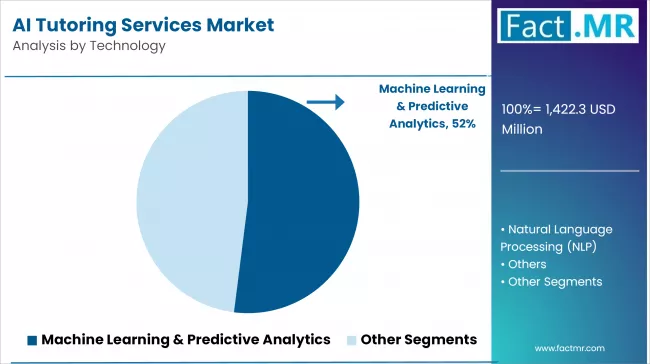
The machine learning & predictive analytics segment is the current leader in AI tutoring services market because it allows offering individual learning trajectories, instant feedback, and future performance estimation. Platforms based on these technologies can self-adjust according to the strengths and weaknesses and the learning pace of an individual student.
This component has acquired a lot of traction among the teaching fraternity and students since it harnesses the power of data analytics to limit learning deficits and streamline study performance. The above predictive algorithms assist in helping forecast areas in which a student might have difficulty, and remedial actions can be taken before the problems escalate.
Cloud-based AI tutoring platforms dominate with accessibility, scalability, and real-time updates
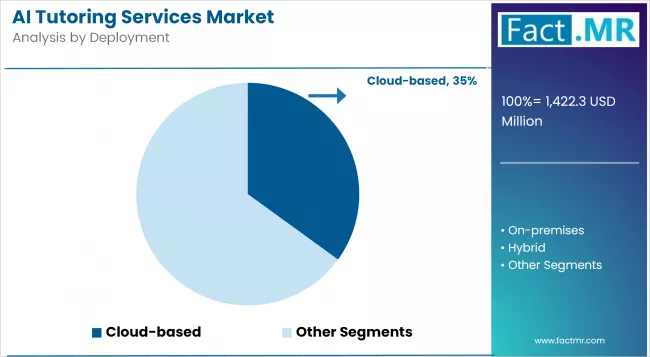
The cloud-based deployment segment is the largest shareholder in the AI tutoring services market because it is easy to access, it scales and provides real-time content updates. AI-powered tutoring on cloud-based solutions, like Khan Academy, Duolingo, and Brainly, enables everyone to access tutoring tools at any location and on any device without having to assemble or maintain complicated local infrastructures.
The segment has been winning robust user trust observing that cloud deployments allow updates, data storage and learning management system integration to be seamless, so educational content and AI algorithms can always be up-to-date and operate effectively. Because of cloud-based platforms, there are collaborations and shared experiences of learning as well as support of group activities and remote classes.
K-12 education leads AI tutoring adoption with personalized learning and performance tracking
The K-12 education segment has the highest market share of the AI tutoring services segment, as a cost-effective mode of personalized learning and interactive digital content, and real-time performance monitoring is in demand. Programs like Khan Academy, Brainly and Carnegie Learning, powered by AI, have also found a popular usage in schools to enable students to master core subject areas such as math, science and language arts.
Educators and parents highly trust this segment because it helps to decrease the learning gaps, offers customized interventions, and increases the engagement of students.
Competitive Analysis
The AI tutoring services market is trending towards hybrid models that incorporate traditional instruction delivery methods with advanced AI-assistance, adaptive learning, and interactive functionality to address the rising demand for multi-purpose learning platforms and learner-centered experiences. Competitiveness also depends on the possibility to prove measurable learning outcomes that point to better retention, mastery of skills, and engagement, as well as on the fact that the platform is both intuitive and adaptive to diverse learners. Adaptability, such as deploying options that include cloud, on-premises and hybrid are becoming a competitive advantage in the market.
How providers can arrange the balance between innovation and user experience, and how they can make sure that AI features do not overburden students and damage the quality of education, is a matter of concern.
Key players in the AI tutoring services industry are McGraw-Hill, CK-12 Foundation, Chegg, Duolingo, Pearson, Sizzle, and others.
Recent Developments
- In April 2025, Berkeley-based startup SigIQ.ai, which develops AI-powered learning platforms, emerged from stealth with $9.5 million in seed funding to expand its technology globally.
- In November 2024, Buddy.ai, an AI-powered tutoring platform for young learners, raised $11 million in a seed funding round led by BITKRAFT Ventures, with support from Edu Capital and others.
Fact.MR has provided detailed information about the price points of key manufacturers of the AI Tutoring Services Market positioned across regions, sales growth, production capacity, and speculative technological expansion, in the recently published report.
Methodology and Industry Tracking Approach
The Global AI Tutoring Services Market report is based on a research done on a sample of over 11,452 professionals, among whom the educational technologists, AI developers, instructional designers, cognitive scientists, edtech adoption specialists, or consumer behavior analysts, were interviewed in depth to carry out the research exercise. Attendees consisted of edtech R&D/product development leaders, administrators of AI education platforms, curriculum developers, marketing specialists, regulatory advisors, and leaders of new AI-based education startups.
The study was based on a horizontal research methodology and the primary research was held through structured questions in the period between September 2024 and July 2025 in order to record multi-perspective understanding that emerges with respect to technology, pedagogy, deployment models, and end-user experiences. The most important aspects of research were the effectiveness of an algorithm, personalization options, engagement levels among the users, data privacy and security, scalability, and assessment accuracy scored by AI. It has also delved into innovation in terms of content delivery, ability to integrate multimedia learning resources, cloud-based versus on-premises sanction, need of commercialization methods and changing adoption of the product across the K-12, higher-ed and corporate training environments and regulatory compliance across locations.
With Fact.MR has been monitoring consumer behavior, product efficacy, industry trends, and market opportunities since 2018. This report is becoming an authoritative source of information that stakeholders can rely on.
Segmentation of AI Tutoring Services Market
-
By Technology :
- Machine Learning & Predictive Analytics
- Natural Language Processing (NLP)
- Others
-
By Deployment :
- Cloud-based
- On-premises
- Hybrid
-
By End-User :
- K-12 Education
- Higher Education
- Corporate Training & Lifelong Learning
-
By Region :
- North America
- Latin America
- Western Europe
- Eastern Europe
- East Asia
- South Asia & Pacific
- Middle East & Africa
Tools & Platforms
InstaLILY Raises $25M to Bring AI Teammates to the Frontlines of Distribution
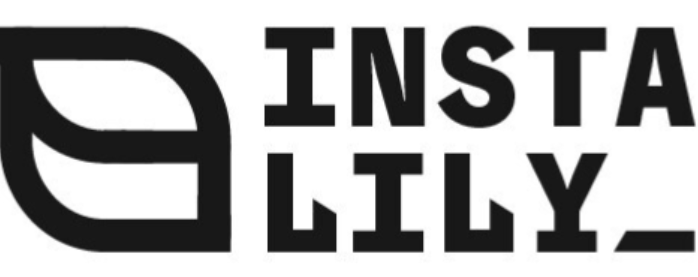
Insider Brief
- InstaLILY AI raised $25M Series A led by Insight Partners, with backing from Perceptive Ventures and Marvin Ventures, to expand its catalog of InstaWorkers™ and deepen enterprise integrations.
- Unlike copilots or chatbots, InstaWorkers™ are domain-trained AI Teammates that execute full workflows inside legacy systems (ERPs, CRMs, ticketing tools) across industries like construction, OEM equipment, and insurance — delivering measurable results such as 70% faster claims processing.
- Purpose-built for execution, InstaLILY is pioneering “Code-as-Work” by embedding AI directly into sales, service, and operations teams — handling quoting, issue triage, and exception management, while extending into multimodal use cases like voice and video support for field service and contact centers.
PRESS RELEASE — InstaLILY AI, the maker of AI Teammates for the world’s most operationally intensive industries, has announced a $25 million Series A funding round led by global software investor Insight Partners, with participation from Perceptive Ventures and Marvin Ventures.
InstaLILY is pioneering a new way to bring AI into the enterprise: instead of stitching together tools or building automation flows, companies can now hire vertical-specific AI Teammates — called InstaWorkers™ — that execute actual work inside legacy systems of records like ERPs, CRMs or any existing software tools.
Purpose-Built for Execution, not just Automation
The platform is purpose-built for distribution-heavy verticals where automation has historically failed. These industries — from physical goods like industrial parts to services like insurance and healthcare — depend on large catalogs, specialized knowledge and fragmented tools, creating high-volume, multi-step work that consumes expert human time. InstaWorkers™ solve this by being trained on the domain-specific processes unique to these industries, navigating their complex software environments without rip-and-replace, and executing full workflows autonomously.
Here’s how InstaWorkers™ get the job done:
- Understand Your Business: They are trained on the domain-specific processes, documentation, and systems unique to your industry.
- Work Across Your Tools: They navigate fragmented software environments (CRMs, ERPs, ticketing platforms) without requiring costly rip-and-replace projects.
- Execute, Not Just Advise: They autonomously complete full workflows, with options for human-in-the-loop oversight, moving beyond simple suggestions to take decisive action.
“We kept hearing the same thing: AI copilots are useful, but they don’t do the work,” said Amit Shah, Founder and CEO of InstaLILY. “InstaWorkers™ are different. They’re AI Teammates — built to execute, not just suggest next steps. That’s the promise of Code-as-Work: AI that radically expands human capacity, not replaces it.”
InstaWorkers™ on the Job
Customers are already deploying teams of InstaWorkers™ to augment their sales, service, and operations staff — with many seeing immediate results:
- A $10B+ construction-supply distributor is empowering its 1,500+ managers with an AI Sales support team. The InstaWorkers™ turn sales data into actionable follow-ups, allowing managers to spend more time on strategic account growth and coaching their teams.
- One of the largest global OEM equipment platforms deploys AI service specialists to support its field technicians. These InstaWorkers™ analyze complex fault descriptions and predict the most likely replacement part from thousands of SKUs, empowering technicians to focus on high-stakes repairs and customer service.
- A PE-backed insurance and healthcare services provider staffed an AI claims operations team to handle high-volume denials. The InstaWorkers™ extract policy and claim data, evaluate it against coverage rules, flag appealable cases, and generate compliant responses — reducing manual review time by 70% and accelerating resolution cycles.
Real Execution, Not Just Assistance
InstaLILY doesn’t just assist — it executes. While horizontal AI platforms focus on summarization, chat, task routing, or surface-level automation, InstaLILY delivers deep, decision-oriented execution. InstaWorkers™ take ownership of the high-stakes, high-variation workflows that drive revenue and service outcomes, such as quoting, issue triage, part validation, and exception handling. This isn’t robotic process automation; it’s domain-trained intelligence built to operate across legacy systems, tribal processes, and real-world complexity.
“These aren’t chatbots,” said Sumantro Das, Co-founder and COO of InstaLILY. “They’re AI Teammates who are embedded in the team and doing the work, not floating around it.”
Investor Perspective
“Hiring a domain-trained AI Teammate is one of those rare ideas that’s both intuitive and built to scale,” said Crissy Costa Behrens, Principal at Insight Partners. “InstaLILY is executing where horizontal AI tools stall — delivering vertical AI that doesn’t just assist but actually owns outcomes. With InstaWorkers™, InstaLILY is helping build a better future of work: grounded in actions, not suggestions.”
What’s Next
With this Series A funding, InstaLILY will expand its catalog of pre-trained InstaWorkers™ across new verticals, deepen integration support for common enterprise systems, and accelerate adoption across sales, service, and operations teams to help customers scale AI Teammate deployments without disrupting their existing workflows. The team is now extending multimodal capabilities even further, enabling agents to process voice and video inputs — unlocking new use cases in field service, contact centers, and human-agent-robot collaboration.
About InstaLILY
InstaLILY is the platform for hiring AI Teammates who already know your industry vertical. Its domain-trained AI agents — called InstaWorkers™ — execute the core sales, service, and operations workflows of distribution-heavy and regulated businesses. Built for execution and immediate impact, InstaWorkers™ plug into your existing tools to deliver value from day one. Learn more at www.instalily.ai
About Insight Partners
Insight Partners is a global software investor partnering with high-growth technology, software, and Internet startup and ScaleUp companies that are driving transformative change in their industries. As of December 31, 2024, the firm has over $90B in regulatory assets under management. Insight Partners has invested in more than 800 companies worldwide and has seen over 55 portfolio companies achieve an IPO. Headquartered in New York City, Insight has offices in London, Tel Aviv, and the Bay Area. Insight’s mission is to find, fund, and work successfully with visionary executives, providing them with tailored, hands-on software expertise along their growth journey, from their first investment to IPO. For more information on Insight and all its investments, visit insightpartners.com or follow us on X @insightpartners.
Tools & Platforms
Gen AI: Faster Than a Speeding BulletNot So Great at Leaping Tall Buildings
FEATURE
Gen AI: Faster Than a Speeding BulletNot So Great at Leaping Tall Buildings
by Christine Carmichael
This article was going to be a recap of my March 2025 presentation at the Computers in Libraries conference (computersinlibraries.infotoday.com).
However, AI technology and the industry are experiencing not just rapid
growth, but also rapid change. And as we info pros know, not all change is
good. Sprinkled throughout this article are mentions of changes since March, some in the speeding-bullet category, others in the not-leaping-tall-buildings one.
Getting Started
I admit to being biased—after all, Creighton University is in my hometown of Omaha—but what makes Creighton special is how the university community lives out its Jesuit values. That commitment to caring for the whole person, caring for our common home, educating men and women to serve with and for others, and educating students to be agents of change has never been more evident in my 20 years here than in the last 2–3 years.
An adherence to those purposes has allowed people from across the campus to come together easily and move forward quickly. Not in a “Move fast and break things” manner, but with an attitude of “We have to face this together if we are going to teach our students effectively.” The libraries’ interest in AI officially started after OpenAI launched ChatGPT-3.5 in November 2022.
Confronted with this new technology, my library colleagues and I gorged ourselves on AI-related information, attending workshops from different disciplines, ferreting out article “hallucinations,” and experimenting with ways to include information about generative AI (gen AI) tools in information literacy instruction sessions. Elon University shared its checklist, which we then included in our “Guide to Artificial Intelligence” (culibraries.creighton.edu/AI).
(Fun fact: Since August 2024, this guide has received approximately 1,184 hits—it’s our fourth-highest-ranked guide.)
 |
Two things inspired and convinced me to do more and take a lead role with AI at Creighton. First was my lifelong love affair with science fiction literature. Anyone familiar with classic science fiction should recognize Asimov’s Three Laws of Robotics. First used in Isaac Asimov’s 1942 short story “Runaround,” they are said to have come from the Handbook of Robotics, 56th Edition, published in 2058. Librarians should certainly appreciate this scenario of an author of fiction citing a fictional source. In our current environment, where gen AI “hallucinates” citations, it doesn’t get more AI than that!
Whether or not these three laws/concepts really work in a scientific sense, you could extrapolate some further guidance for regulating development and deployment of these new technologies to mitigate harm. Essentially, it’s applying the Hippocratic oath to AI.
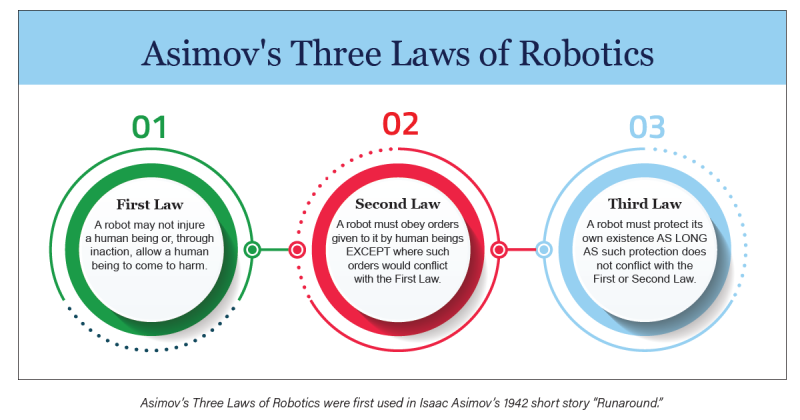 |
The second inspiration came from a February 2023 CNN article by Samantha Murphy Kelly (“The Way We Search for Information Online Is About to Change”; cnn.com/2023/02/09/tech/ai-search/index.html), which claims that the way we search for information is never going to be the same. I promptly thought to myself, “Au contraire, mon frère, we have been here before,” and posted a response on Medium (“ChatGPT Won’t Fix the Fight Against Misinformation”; medium.com/@christine.carmichael/chatgpt-wont-fix-the-fight-against-misinformation-15c1505851c3).
What Happened Next
Having a library director whose research passion is AI and ethics enabled us to act as a central hub for convening meetings and to keep track of what is happening with AI throughout the campus. We are becoming a clearinghouse for sharing information about projects, learning opportunities, student engagement, and faculty development, as well as pursuing library-specific projects.
After classes started in the fall 2024, the director of Magis Core Curriculum and the program director for COM 101—a co-curricular course requirement which meets oral communication and information literacy learning objectives—approached two research and instruction librarians, one being me. They asked us to create a module for our Library Encounter Online course (required in COM 101) to explain some background of AI and how large language models (LLMs) work. The new module was in place for spring 2025 classes.
In November 2024, the library received a $250,000 Google grant, which allowed us to subscribe to and test three different AI research assistant tools—Scopus, Keenious, and Scite. We split into three teams, each one responsible for becoming the experts on a particular tool. After presenting train-the-trainer sessions to each other, we restructured our teams to discuss the kinds of instruction options we could use: long, short, online (bite-sized).
We turned on Scopus AI in late December 2024. Team Scopus learned the tool’s ins and outs and describe it as “suitable for general researchers, upper-level undergraduates, graduate/professional students, medical residents, and faculty.” Aspects of the tool are particularly beneficial to discovering trends and gaps in research areas. One concern the team has remains the generation of irrelevant references. The team noticed this particularly when comparing the same types of searches in “regular” Scopus vs. Scopus AI.
Team Keenious was very enthusiastic and used an evaluation rubric from Rutgers University (credit where it’s due!). The librarians’ thoughts currently are that this tool is doing fairly well at “being a research recommendation tool” for advanced researchers. It has also successfully expanded the “universe” of materials used in systematic reviews. However, reservations remain as to its usefulness for undergraduate assignments, particularly when that group of students may not possess the critical thinking skills necessary to effectively use traditional library resources.
Scite is the third tool in our pilot. The platform is designed to help researchers evaluate the reliability of research papers using three categories: citations supporting claims, citations contrasting claims, and citations without either. Team Scite.ai” liked the tool, but recognized that it has a sizable learning curve. One Team Scite.ai member summed up their evaluation like this: “Much like many libraries, Scite.ai tries to be everything to everyone, but it lacks the helpful personal guide-on-the-side that libraries provide.”
The official launch and piloting the use of these tools began in April 2025 for faculty. We will introduce them to students in the fall 2025 semester. However, because the Scopus AI tool is already integrated and sports a prominent position on the search page, we anticipate folks using that tool before we get an opportunity to market it.
The Google funding also enabled the Creighton University Libraries to partner with several departments across campus in support of a full-day faculty development workshop in June. “Educating the Whole Person in an AI-Driven World” brought almost 150 faculty and staff together for the common purpose of discerning (another key component of Jesuit education) where and how we will integrate AI literacies into the curriculum. In addition to breakout sessions, we were introduced to a gen AI SharePoint site, the result of a library collaboration with the Center for Faculty Excellence.
ETHICS AND AI
Our director is developing a Jesuit AI Ethics Framework. Based on Jesuit values and Catholic Social Teaching, the framework also addresses questions asked by Pope Francis and the Papal Encyclical, Laudato si’, which asks us to care for our common home by practicing sustainability. Because of our extensive health sciences programs, a good portion of this ethical framework will focus on how to maintain patient and student privacy when using AI tools.
Ethics is a huge umbrella. These are things we think bear deeper dives and reflection:
The labor question: AI as a form of automation
We had some concerns and questions about AI as it applies to the workforce. Is it good if AI takes people’s jobs or starts producing art? Where does that leave the people affected? Note that the same concerns were raised about automation in the Industrial Revolution and when digital art tablets hit the market.
Garbage in, garbage out (GIGO): AIs are largely trained on internet content, and much of that content is awful.
We were concerned particularly about the lack of transparency: If we don’t know what an AI model is trained on, if there’s no transparency, can we trust it—especially for fields like healthcare and law, where there are very serious real-word implications? In the legal field, AI has reinforced existing biases, generally assuming People of Color (POCs) to be guilty.
Availability bias is also part of GIGO. AIs are biased by the nature of their training data and the nature of the technology itself (pattern recognition). Any AI trained on the internet is biased toward information from the modern era. Scholarly content is biased toward OA, and OA is biased by different field/author demographics that indicate who is more or less likely to publish OA.
AI cannot detect sarcasm, which may contribute to misunderstanding about meaning. AI chatbots and LLMs have repeatedly shown sexist, racist, and even white supremacist responses due to the nature of people online. What perspectives are excluded from training data (non-English content)? What about the lack of developer diversity (largely white Americans and those from India and East Asia)?
Privacy, illegal content sourcing, financial trust issues
Kashmir Hill’s 2023 book, Your Face Belongs to Us: A Secretive Startup’s Quest to End Privacy (Penguin Random House), provides an in-depth exposé on how facial recognition technology is being (mis)used. PayPal founder Peter Thiel invested $200,000 into a company called SmartCheckr, which eventually became Clearview AI, specializing in facial recognition. Thiel was a Facebook board member with a fiduciary responsibility at the same time that he was investing money in a company that was illegally scraping Facebook content. There is more to the Clearview AI story, including algorithmic bias issues with facial recognition. Stories like this raise questions about how to regulate this technology.
Environmental impacts
What about energy and water use and their climate impacts? This is from Scientific American: “A continuation of the current trends in AI capacity and adoption are set to lead to NVIDIA shipping 1.5 million AI server units per year by 2027. These 1.5 million servers, running at full capacity, would consume at least 85.4 terawatt-hours of electricity annually—more than what many small countries use in a year, according to the new assessment“ (scientificamerican.com/article/the-ai-boom-could-use-a-shocking-amount-of-electricity).
In May 2025, MIT Technology Review released a new report, “Power Hungry: AI and Our Energy Future” (technologyreview.com/supertopic/ai-energy-package), which states, “The rising energy cost of data centers is a vital test case for how we deal with the broader electrification of the economy.”
It’s Not All Bad News
There are days I do not even want to open my newsfeed because I know I will find another article detailing some new AI-infused horror, like this one from Futurism talking about people asking ChatGPT how to administer their own facial fillers (futurism.com/neoscope/chatgpt-advice-cosmetic-procedure-medicine). Then there is this yet-to-be-peer-reviewed article about what happens to your brain over time when using an AI writing assistant (“Your Brain on ChatGPT: Accumulation of Cognitive Debt When Using an AI Assistant for Essay Writing Task”; arxiv.org/pdf/2506.08872v1). It is reassuring to know that there are many, many people who are not invested in the hype, who are paying attention to how gen AI is or is not performing.
There are good things happening. For instance, ResearchRabbit and Elicit, two well-known AI research assistant tools, use the corpus of Semantic Scholar’s metadata as their training data. Keenious, one of the tools we are piloting, uses OpenAlex for its training corpus.
On either coast of the U.S. are two outstanding academic research centers focusing on ethics: Santa Clara University’s Markkula Center for Applied Ethics (scu.edu/ethics/focus-areas/internet-ethics) and the Berkman Klein Center for Internet and Society at Harvard University (cyber.harvard.edu).
FUTURE PLANS
We have projects and events planned for the next 2 years:
- Library director and School of Medicine faculty hosting a book club using Teaching With AI: Navigating the Future of Education
- Organizing an “unconference” called Research From All Angles Focusing on AI
- Hosting a Future of Work conference with Google
- Facilitating communities of practice around different aspects of AI: teaching, research, medical diagnostics, computing, patient interaction, etc.
As we get further immersed, our expectations of ourselves need to change. Keeping up with how fast the technology changes will be nigh on impossible. We must give ourselves and each other the grace to accept that we will never “catch up.” Instead, we will continue to do what we excel at—separating the truth from the hype, trying the tools for ourselves, chasing erroneous citations, teaching people to use their critical thinking skills every time they encounter AI, learning from each other, and above all, sharing what we know.
Tools & Platforms
Is AI ‘The New Encyclopedia’? As The School Year Begins, Teachers Debate Using The Technology In The Classroom

As the school year gets underway, teachers across the country are dealing with a pressing quandary: whether or not to use AI in the classroom.
Ludrick Cooper, an eighth-grade teacher in South Carolina, told CNN that he’s been against the use of AI inside and outside the classroom for years, but is starting to change his tune.
“This is the new encyclopedia,” he said of AI.
Don’t Miss:
There are certainly benefits to using AI in the classroom. It can make lessons more engaging, make access to information easier, and help with accessibility for those with visual impairments or conditions like dyslexia.
However, experts also have concerns about the negative impacts AI can have on students. Widening education inequalities, mental health impacts, and easier methods of cheating are among the main downfalls of the technology.
“AI is a little bit like fire. When cavemen first discovered fire, a lot of people said, ‘Ooh, look what it can do,'” University of Maine Associate Professor of Special Education Sarah Howorth told CNN. “And other people are like, ‘Ah, it could kill us.’ You know, it’s the same with AI.”
Several existing platforms have developed specific AI tools to be used in the classroom. In July, OpenAI launched “Study Mode,” which offers students step-by-step guidance on classwork instead of just giving them an answer.
Trending: Kevin O’Leary Says Real Estate’s Been a Smart Bet for 200 Years — This Platform Lets Anyone Tap Into It
The company has also partnered with Instructure, the company behind the learning platform Canvas, to create a new tool called the LLM-Enabled Assignment. The tool will allow teachers to create AI-powered lessons while simultaneously tracking student progress.
“Now is the time to ensure AI benefits students, educators, and institutions, and partnerships like this are critical to making that happen,” OpenAI Vice President of Education Leah Belsky said in a statement.
While some teachers are excited by these advancements and the possibilities they create, others aren’t quite sold.
Stanford University Vice Provost for Digital Education Matthew Rascoff worries that tools like this one remove the social aspect of education. By helping just one person at a time, AI tools don’t allow opportunities for students to work on things like collaboration skills, which will be vital in their success as productive members of society.
-

 Business3 days ago
Business3 days agoThe Guardian view on Trump and the Fed: independence is no substitute for accountability | Editorial
-
Tools & Platforms3 weeks ago
Building Trust in Military AI Starts with Opening the Black Box – War on the Rocks
-

 Ethics & Policy1 month ago
Ethics & Policy1 month agoSDAIA Supports Saudi Arabia’s Leadership in Shaping Global AI Ethics, Policy, and Research – وكالة الأنباء السعودية
-

 Events & Conferences3 months ago
Events & Conferences3 months agoJourney to 1000 models: Scaling Instagram’s recommendation system
-

 Jobs & Careers2 months ago
Jobs & Careers2 months agoMumbai-based Perplexity Alternative Has 60k+ Users Without Funding
-

 Funding & Business2 months ago
Funding & Business2 months agoKayak and Expedia race to build AI travel agents that turn social posts into itineraries
-

 Education2 months ago
Education2 months agoVEX Robotics launches AI-powered classroom robotics system
-

 Podcasts & Talks2 months ago
Podcasts & Talks2 months agoHappy 4th of July! 🎆 Made with Veo 3 in Gemini
-

 Mergers & Acquisitions2 months ago
Mergers & Acquisitions2 months agoDonald Trump suggests US government review subsidies to Elon Musk’s companies
-

 Podcasts & Talks2 months ago
Podcasts & Talks2 months agoOpenAI 🤝 @teamganassi

